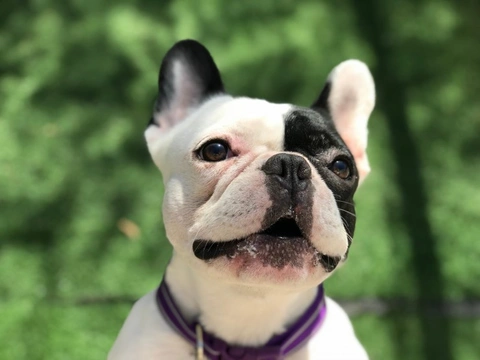
Tear staining in the French bulldog
Excessive tear production is an issue that can affect dogs of many different breeds and types, and which usually causes tear staining, which is noticeable and hard to remove. French bulldogs are one of the dog breeds that are prone to excessive tear production and tear staining, and there are a whole host of different things that can cause it to happen.
Tear staining can be a superficial nuisance that may even lead to your dog being penalised in the show ring, but it is always an indicator of an underlying issue, which is why finding out what causes tear staining in your French bulldog is so important.
In this article we will look at tear staining in the French bulldog in more detail, including the most common causes of tear staining and what they mean for your dog. Read on to learn more.
Why do tear stains develop?
Put simply, tear staining occurs when your dog’s tear ducts produce too much moisture, which drains from the eyes down the face. The veterinary term for this is epiphora, and getting to the bottom of why your French bulldog has tear stains relies upon finding out what’s causing their tear ducts to produce too much moisture in the first place, or what is stopping the moisture from draining normally.
What causes excessive tear production in the French bulldog?
There are a wide and diverse range of reasons why your French bulldog might have excessive tear production, and finding out which of them is causing the problem is the key to resolving it. Many French bulldog puppy buyers will find that their pups will produce excessive tears during their formative first few months of life, as their conformation develops and their faces change shape to take on their adult forms.
Frenchies may also produce more tears than normal during teething, but tear staining and excessive tear production in French bulldog pups often clears up on its own as the dog gets older.
However, if they still show tear staining when adult, or develop tear staining for the first time when they are fully grown, it is important to look into the issue.
Next, we will look at some of the most common causes of tear staining in fully grown French bulldogs.
Closed tear ducts
Your dog’s tear drainage channels can become clogged or blocked, and close up – which can lead to tear staining because the eyes can’t drain normally. If this occurs, your vet will need to sedate your dog and flush the tear ducts to remove the blockage, and allow them to drain normally again.
Distichiasis
Distichiasis is the name given to abnormal growth of the dog’s eyelashes, leading to them rubbing on the cornea and irritating the eyes. Tear production will increase as the dog’s body attempts to remove or flush out the source of irritation – but because it is caused by eyelashes and so, cannot be flushed from the eye, this is ineffective.
Distichiasis may occur if your dog has particularly prominent or protruding eyes that cause the eyelids to turn inwards, or if the conformation of their eyes otherwise causes problems, as well as if the eyelashes grow crooked or in odd directions.
Conformation defects
Problems or flaws in your dog’s conformation can lead to the tear ducts themselves not forming properly, which can lead to the tear ducts not draining naturally. In some cases, the drainage holes in the bottom of the tear ducts, which should allow moisture to drain naturally via the nose, may be closed or too small to allow this to happen. This leads to the moisture running down your dog’s face instead, causing tear staining.
Allergies and infections
If your Frenchie suffers from allergies or is prone to developing eye infections, this can lead to swelling and irritation of the eyes, which in turn, can occlude the tear ducts’ natural drainage channels and lead to tear staining.
Clearing up the infection of bringing the dog’s allergy under control will help to resolve the issue.
Foreign bodies
Many French bulldogs have large, prominent eyes, which places them at greater risk of damage and irritation. Foreign bodies – even small particles of grit or muck – can work their way into your dog’s tear ducts, causing blockages and irritations.
Scarring of the inner eye
Scarring inside of the eye can develop over time if your dog has had an eye injury, or even as the result of a nasty infection. Distichiasis that is left untreated can also cause scar tissue to develop, all of which can result in excessive tear production or potentially, a blockage of the tear ducts.
Getting to the bottom of tear staining in the French bulldog
Tear staining never happens without a reason, and whilst it is easy to write off the issue as largely cosmetic and so, view it as reasonably minor, it is important to work with your vet to establish why it is happening, and resolve the underlying issue.
Many of the issues that cause tear staining in the French bulldog can be painful or irritating for your dog, as well as increasing the risk of scarring and so, the future development of further problems.
Don’t ignore tear staining, particularly if you don’t know why it is happening – ask your vet to check your dog out and get their advice on how to proceed.



